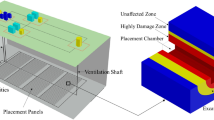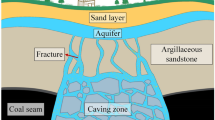Abstract
This paper presents an analysis using temporal moments to study multi-species radionuclide transport along a single fracture with variable fracture aperture in a fracture-skin-matrix system. In the present study, a decay chain having three elements is considered and transport of each member in the decay chain is modeled by solving a coupled system of partial differential equations for fracture, fracture-skin, and rock matrix using explicit finite difference method. Having obtained the concentration distribution, lower order temporal moments of radionuclide distribution are computed to analyze the effective velocity and macro-dispersion coefficient of radionuclides in the fracture. In the present study, effect of varying fracture aperture on transport characteristics of radionuclides is also analyzed. It is found that the fracture aperture variation profile has significant impact on radionuclide distribution along the fracture. Sensitivity analysis is carried out in a fracture-skin-matrix system with sinusoidal fracture aperture to study the effect of various parameters like fracture aperture thickness, fracture-skin porosity, fracture-skin diffusion coefficient, flow rate, radioactive decay constant, and Freundlich sorption isotherm exponent on transport characteristics of radionuclide. The results suggest that the above mentioned parameters significantly influence concentration, distribution, mobility, and effective macro-dispersion coefficient of radionuclides along the fracture.














Similar content being viewed by others
References
Abdel-Salam, A., & Chrysikopoulos, C. V. (1995). Modeling of colloid and colloid-facilitated contaminant transport in a two-dimensional fracture with spatially variable aperture. Transport in Porous Media, 20, 197–221.
Alexander, A, R., Smellie, J. A. T., Pitty, A., F. (2011). Introduction. Ch 1 In: Pitty A.F. (ed). A natural analogue study of cement buffered, hyperalkaline groundwaters and their interaction with a repository host rock IV: an examination of the Khushaym Matruk (central Jordan) and Maqarin (northern Jordan) sites. NDA Technical Report, NDA, Moor Row.
Bardsley, W. E. (2003). Temporal moments of a tracer pulse in a perfectly parallel flow system. Advances in Water Resource Research, 26(6), 599–607.
Barenblatt, G. I., Zheltov, I. P., & Kochina, I. N. (1960). Basics concepts in the theory of seepage of homogeneous liquids in fissured rocks. Journal of Applied Mathematics and Mechanics, 24, 1286–1303.
Bauer, P., Attinger, S., & Kinzelbach, W. (2001). Transport of a decay chain in homogenous porous media: analytical solutions. Journal of Contaminant Hydrology, 49, 217–239.
Bibby, R. (1981). Mass transport of solutes in dual-porosity media. Water Resources Research, 17(4), 1075–1081.
Bodin, J., Delay, F., & de Marsily, G. (2003). Solute transport in a single fracture with negligible matrix permeability: I. Fundamental mechanisms. Hydrogeology Journal, 11, 418–433.
Bosma, W. J. P., & van der Zee, S. E. A. T. M. (1995). Dispersion of a continuously injected, nonlinearly adsorbing solute in chemically or physically heterogeneous porous formations. Journal of Contaminant Hydrology, 18(3), 181–198.
Cunningham, J., & Roberts, P. V. (1998). Use of temporal moments to investigate the effects of non-uniform grain-size distribution on the trans- port of sorbing solutes. Water Resources Research, 34, 1415–1425.
Cvetkovic, V., Selroos, J. O., & Cheng, H. (1999). Transport of reactive tracers in rock fractures. Journal of Fluid Mechanics, 378, 335–356.
Dijk, P., & Berkowitz, B. (1998). Precipitation and dissolution of reactive solutes in fractures. Water Resources Research, 34(3), 457–470.
Driese, S. G., McKay, L. D., & Penfield, C. P. (2001). Lithologic and pedogenic influences on porosity distribution and groundwater flow in fractured sedimentary saprolite: a new application of environmental sedimentology. Journal of Sedimentary Research, 71(5), 843–857.
El Samad, O., Aoun, M., Nsouli, B., Khalaf, G., & Hamze, M. (2014). Investigation of the radiological impact on the coastal environment surrounding a fertilizer plant. Journal of Environmental Radioactivity, 133, 69–74.
Fu, L., Milliken, K. L., & Sharp, J. M. (1994). Porosity and permeability variations in the fractured and liesegang-banded Breathitt Sandstone (Middle Pennsylvanian), eastern Kentucky: diagenetic controls and implications for modelling dual porosity systems. Journal of Hydrology, 154, 351–381.
Gale J E., Rouleau A., Atkinson L C. (1985). Hydraulic properties of fractures. Proceedings, Int. Assoc. of Hydrogeologists, Memoirs, Tucson Congress, 17:1–11.
Garner T T., Sharp J M. (2004). Hydraulic properties of granitic fracture skins and their 540 effects on solute transport, In: Proceedings, 2004 U.S EPA/NGWA, Fractured rock 541 conference: State of the science and Measuring success in remediation, national 542 Groundwater Association. Dublin pp 664–678.
Govindarajau, R. S., & Das, B. S. (2007). Moment analysis for sub-surface hydrologic applications. Dordrecht: Springer.
Grisak, G. E., & Pickens, J. F. (1980). Solute transport through fractured media. I: the effect of matrix diffusion. Water Resources Research, 16(4), 719–730.
Grisak, G. E., & Pickens, J. F. (1980). Solute transport through fractured media. II: column study of fractured till. Water Resources Research, 16(4), 731–739.
Kreft, A., & Zuber, A. (1978). On the physical meaning of the dispersion equation and its solutions for different initial and boundary conditions. Chemical Engineering Science, 33, 1471–1480.
Kreisel I., Sharp J M. (1996). Fracture skins in the Brushy Canyon Formation. In: DeMis W. D., Cole A.G. (Eds.). The brushy canyon play in outcrop and subsurface: concepts and examples. PBS-SEPM: 96–38, Midland: 147–152.
Landrum M T. (2000) Hydrogeologic properties of fracture skins and their effects on radionuclide transport: Thesis (Masters).The University of Texas: Austin.
Leube PC., Nowak W., Schneider G. (2012). Temporal moments revisited: why there is no better way for physically based model reduction in time. Water Resources Research 48 doi: 10.1029/2012WR011973.
Lichtner, P. C. (2000). Critique of dual continuum formulations of multicomponent reactive transport in fractured porous media. Geophysical Monograph, 122, 281–298.
Luo, J., Cirpka, O. A., Dentz, M., & Carrera, J. (2008). Temporal moments for transport with mass transfer described by an arbitrary memory function in heterogeneous media. Water Resources Research, 44, 1–7.
Maloszewski, P., & Zuber, A. (1985). On the theory of tracer experiments in fissured rocks with a porous matrix. Journal of Hydrology, 79, 333–358.
Maloszewski, P., & Zuber, A. (1990). Mathematical modeling of tracer behavior in short-term tracer experiments and fissured rocks. Water Resources Research, 26, 1517–1528.
Moench, A. F. (1984). Double-porosity models for a fissured groundwater reservoir with fracture skin. Water Resources Research, 20, 831–846.
Moench, A. F. (1985). Convergent radial dispersion in a double-porosity aquifer with fracture skin: analytical solution and application to a field experiment in fractured chalk. Water Resources Research, 31, 1823–1835.
Naff, R. L. (1992). Arrival times and temporal moments of breakthrough curves for an imperfectly stratified aquifer. Water Resources Research, 28, 53–68.
Natarajan, N., & Suresh Kumar, G. (2010). Radionuclide and colloid co-transport in a coupled fracture-skin-matrix system. Colloids and Surfaces, A: Physiochemical and Engineering Aspects, 370, 49–57.
Neiva, M. R., Carvalho, P. C. S., Antunes, I. M. H. R., Silva, M., Santos, M. V. G., Cabral, A. C. T., Pinto, M. M. S., & Cunha, P. P. (2014). Contaminated water, stream sediments and soils close to the abandoned Pinhal do Souto uranium mine, central Portugal. Journal of Geochemical Exploration, 136, 102–117. doi:10.1016/j.gexplo.2013.10.014.
Neretneik, I. (1980). Diffusion in the rock matrix: an important factor in radionuclide retardation? Journal of Geophysical Research, 85(B8), 4379–4397.
Neretneiks, I. (1983). A note on fracture flow dispersion mechanisms in the ground. Water Resources Research, 19(2), 364–370.
Phyu T. (2002). Transient modeling of contaminant transport in dual porosity media with fracture skins: Thesis (Masters).The University of Texas at Astin.
Ramuson, A. (1985). Analysis of hydrodynamic dispersion in discrete aquifer networks using the method of moments. Water Resources Research, 21, 1677–1683.
Renu, V., & Suresh Kumar, G. (2012). Numerical modeling and spatial moment analysis of solute mobility and spreading in a coupled fracture-skin-matrix system. Geotechnical and Geological Engineering, 30(6), 1289–1302.
Renu, V., & Suresh Kumar, G. (2014). Temporal moment analysis of solute transport in a coupled fracture-skin-matrix system. Sadhana, 39(2), 487–509.
Robinson N. I., Sharp Jr J M. (1997). Analytical solution for contaminant transport in a 601 finite set of parallel fractures with matrix diffusion. C.S.I.R.O. Mathematical and 602 Information Sciences Report CMIS-C23.
Robinson, N. I., Sharp, J. M., & Ilan, K. (1998). Contaminant transport in a set of parallel fractures with fracture skin. Journal of Contaminant Hydrology, 31, 83–109.
Schrauf, T. W., & Evans, D. D. (1986). Laboratory studies of gas flow through a single natural fracture. Water Resources Research, 22, 38–1050.
Sekhar, M., & Suresh Kumar, G. (2005). Modeling transport of linearly sorbing solutes in a single fracture: asymptotic behavior of solute velocity and dispersivity. Geotechnical and Geological Engineering, 24(1), 183–201.
Sekhar, M., Suresh Kumar, G., & Misra, D. (2006). Numerical modeling and analysis of solute velocity and macrodispersion for linearly and nonlinearly sorbing solutes in a single fracture with matrix diffusion. Journal of Hydrological Engineering, 11(4), 319–328.
Sharma, P. K., Sekhar, M., Srivastava, R., & Ojha, C. S. P. (2012). Temporal moments for reactive transport through fractured impermeable/permeable formations. Journal of Hydrological Engineering, 17, 1302–1314.
Sharp J M. (1993). Fractured aquifers/reservoirs; approaches, problems, and opportunities. In: Banks D., Banks S. (Eds.) Hydrogeology of hard rocks, memoires of the 24th Cong. International Assoc. Hydrogeologists. Oslo, Norway, 24, 615(1), 23–38.
Sharp, J. M., Robinson, N. I., Smyth-Boulton, R. C., & Milliken, K. L. (1995). Fracture skin effects in groundwater transport. In H. P. Rossmanith (Ed.), Mechanics of jointed and faulted rock (pp. 449–454). Rotterdam: A.A. Balkeme.
Singh, J., Singh, H., Singh, S., Bajwa, B. S., & Sonkawade, R. G. (2009). Comparative study of natural radioactivity levels in soil samples from the Upper Siwaliks and Punjab, India using gamma-ray spectrometry. Journal of Environmental Radioactivity, 100(1), 94–98.
Suresh Kumar, G. (2008). Effect of sorption intensities on dispersivity and macro-dispersion coefficient in a single fracture with matrix diffusion. Hydrogeology Journal, 16(2), 235–249.
Suresh Kumar, G. (2009). Influence of sorption intensity on solute mobility in a fractured formation. Journal of Environmental Engineering, 135(1), 1–7.
Suresh Kumar, G. (2014). Mathematical modeling of groundwater flow and solute transport in a saturated fractured rock using dual-porosity approach. Journal of Hydrological Engineering, 10, 1061. doi:1943–5584.0000986.
Suresh Kumar, G., Sekhar, M., & Misra, D. (2011). Spatial and temporal moment analyses of decaying solute transport in a single fracture with matrix diffusion. Journal of Petroleum Geosystem Science and Engineering, 1(1), 1–20.
Tang, D. H., Frind, E. O., & Sudicky, E. A. (1981). Contaminant transport in fractured porous media: analytical solution for a single fracture. Water Resources Research, 17(3), 467–480.
Taskin, H., Karavus, M., Ay, A., Topuzoglu, A., Hidiroglu, S., & Karahan, G. (2009). Radionuclide concentrations in soil and lifetime cancer risk due to gamma radioactivity in Kirklareli, Turkey. Journal of Environmental Radioactivity, 100(1), 49–53.
Tsang, C. F., Barnichon, B. D., Birkholzer, J., Li, X. L., Liu, H. H., & Sillen, X. (2012). Coupled thermo-hydro-mechanical processes in the near field of a high-level radioactive waste repository in clay formations. International Journal Rock of Mechanics and Mining Engineering, 2012(49), 31–44.
Tsang, Y. W., & Tsang, C. F. (2001). A particle-tracking method for advective transport in fractures with diffusion into finite matrix blocks. Water Resources Research, 37(3), 831–835.
Valocchi, A. J. (1985). Validity of the local equilibrium assumption for modeling sorbing solute transport through homogeneous soil. Water Resources Research, 21, 808–820.
Van den Akker, B. P., & Ahn, J. (2014). 1-D modeling of radionuclide transport via heterogeneous geological formations for arbitrary length decay chains using numerical inversion of Laplace transforms. Annals of Nuclear Energy, 63, 763–773.
Warren, J., & Root, P. (1963). The behavior of naturally fractured reservoirs. Transactions of the Society of Mining Engineers of AIME, 228, 245–255.
Yeo, I. W. (2001). Effect of fracture roughness on solute transport. Geosciences Journal, 5, 145–151.
Zimmerman, M. D., Bennett, P. C., Sharp, J. M., & Choi, W. J. (2002). Experimental determination of sorption in fractured flow systems. Journal of Contaminant Hydrology, 58(12), 51–77.
Acknowledgments
The authors would like to thank the corresponding editor as well as the anonymous reviewer for their valuable comments and suggestions to improve the quality of the manuscript.
Author information
Authors and Affiliations
Corresponding author
Rights and permissions
About this article
Cite this article
Renu, V., Suresh Kumar, G. Temporal Moment Analysis of Multi-Species Radionuclide Transport in a Coupled Fracture-Skin-Matrix System with a Variable Fracture Aperture. Environ Model Assess 21, 547–562 (2016). https://doi.org/10.1007/s10666-016-9515-5
Received:
Accepted:
Published:
Issue Date:
DOI: https://doi.org/10.1007/s10666-016-9515-5




